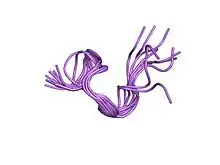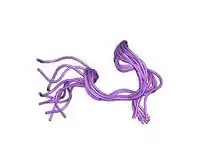| guanylate cyclase activator 2A (guanylin) | |||||||
|---|---|---|---|---|---|---|---|
 Solution structure of human proguanylin.[1] | |||||||
| Identifiers | |||||||
| Symbol | GUCA2A | ||||||
| Alt. symbols | GUCA2 | ||||||
| NCBI gene | 2980 | ||||||
| HGNC | 4682 | ||||||
| OMIM | 139392 | ||||||
| PDB | 1O8R | ||||||
| RefSeq | NM_033553 | ||||||
| UniProt | Q02747 | ||||||
| Other data | |||||||
| Locus | Chr. 1 p35-p34 | ||||||
| |||||||
| Guanylin precursor | |||||||||||
|---|---|---|---|---|---|---|---|---|---|---|---|
| Identifiers | |||||||||||
| Symbol | Guanylin | ||||||||||
| Pfam | PF02058 | ||||||||||
| InterPro | IPR000879 | ||||||||||
| SCOP2 | 1uyb / SCOPe / SUPFAM | ||||||||||
| |||||||||||
Guanylin is a 15 amino acid peptide that is secreted by goblet cells in the colon. Guanylin acts as an agonist of the guanylyl cyclase receptor GC-C and regulates electrolyte and water transport in intestinal and renal epithelia.[2][3] Upon receptor binding, guanylin increases the intracellular concentration of cGMP, induces chloride secretion and decreases intestinal fluid absorption, ultimately causing diarrhoea.[4] The peptide stimulates the enzyme through the same receptor binding region as the heat-stable enterotoxins.[3]
Researches have found that a loss in guanylin expression can lead to colorectal cancer due to guanylyl cyclase C's function as an intestinal tumor suppressor.[5] When guanylin expression was measured on over 250 colon cancer patients, more than 85% of patients had a loss of guanylin expression in cancerous tissue samples by 100-1000 times when compared to the same patients's nearby healthy colon tissue.[5] Another study done on genetically engineered mice found that mice on a high calorie diet had reduced guanylin expression in the colon.[6] This loss of expression then resulted in guanylyl cyclase C inhibition and the formation of tumors, therefore linking diet-induced obesity with colorectal cancer. [6]
Human proteins containing this domain
GUCA2A; GUCA2B;
Structure
This peptide has two topogies,[7] both isoforms are shown below:
 Structure of the A-form of human uroguanylin.[7] |
 Structure of the B-form of human uroguanylin.[7] |
References
- ↑ PDB: 1O8R; Lauber T, Neudecker P, Rösch P, Marx UC (June 2003). "Solution structure of human proguanylin: the role of a hormone prosequence". The Journal of Biological Chemistry. 278 (26): 24118–24. doi:10.1074/jbc.M300370200. PMID 12707255.
- ↑ Sciaky D, Kosiba JL, Cohen MB (December 1994). "Genomic sequence of the murine guanylin gene". Genomics. 24 (3): 583–7. doi:10.1006/geno.1994.1670. PMID 7713512.
- 1 2 de Sauvage FJ, Keshav S, Kuang WJ, Gillett N, Henzel W, Goeddel DV (October 1992). "Precursor structure, expression, and tissue distribution of human guanylin". Proceedings of the National Academy of Sciences of the United States of America. 89 (19): 9089–93. Bibcode:1992PNAS...89.9089D. doi:10.1073/pnas.89.19.9089. PMC 50070. PMID 1409606.
- ↑ Currie MG, Fok KF, Kato J, Moore RJ, Hamra FK, Duffin KL, Smith CE (February 1992). "Guanylin: an endogenous activator of intestinal guanylate cyclase". Proceedings of the National Academy of Sciences of the United States of America. 89 (3): 947–51. Bibcode:1992PNAS...89..947C. doi:10.1073/pnas.89.3.947. PMC 48362. PMID 1346555.
- 1 2 Tanday S (November 2014). "Guanylin hormone loss could trigger colon cancer". The Lancet. Oncology. 15 (12): e537. doi:10.1016/s1470-2045(14)71032-0. PMID 25602115.
- 1 2 Lin JE, Colon-Gonzalez F, Blomain E, Kim GW, Aing A, Stoecker B, et al. (January 2016). "Obesity-Induced Colorectal Cancer Is Driven by Caloric Silencing of the Guanylin-GUCY2C Paracrine Signaling Axis". Cancer Research. 76 (2): 339–46. doi:10.1158/0008-5472.CAN-15-1467-T. PMC 4717834. PMID 26773096.
- 1 2 3 Marx UC, Klodt J, Meyer M, Gerlach H, Rösch P, Forssmann WG, Adermann K (September 1998). "One peptide, two topologies: structure and interconversion dynamics of human uroguanylin isomers". The Journal of Peptide Research. 52 (3): 229–40. doi:10.1111/j.1399-3011.1998.tb01480.x. PMID 9774236.
External links
- guanylin at the U.S. National Library of Medicine Medical Subject Headings (MeSH)